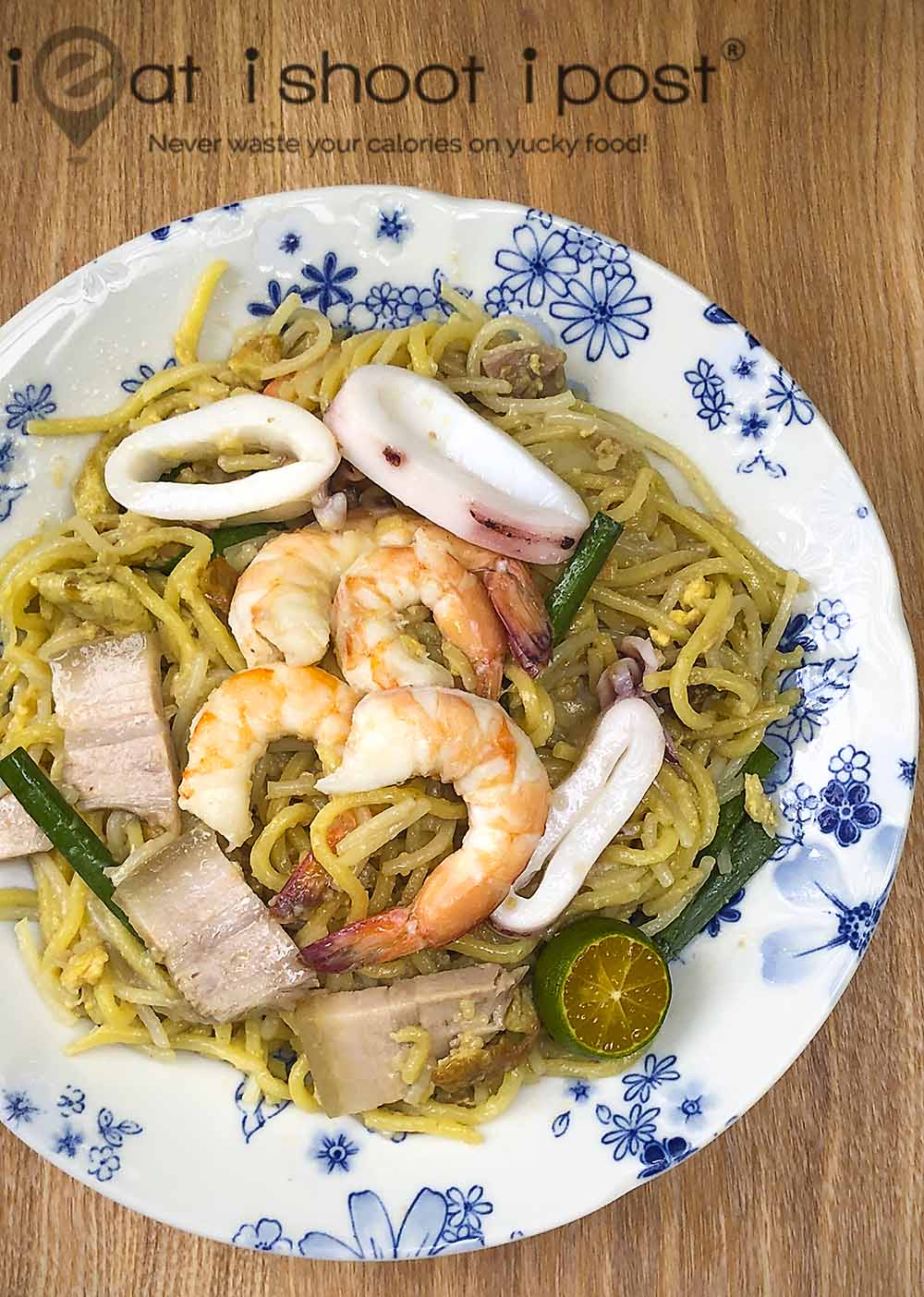
Check out my newly updated hokkien mee recipe here!
Hokkien mee is one of my all time favourite hawker dishes. It is also a dish that is unique to Singapore. There are many theories as to the origins of the dish, but what is undisputed is that you can’t find this style of Hokkien mee in our neighbouring countries, unlike char kway teow where many variations can be found across Malaysia. Malaysia does have its own “Hokkien Mee” but the only thing they have in common is the noodles. KL Hokkien mee is quite a different dish altogether, both in terms of flavour and in the method of cooking.
I am writing this recipe to document some of the important aspects of frying Hokkien which I have gleaned over the years from some of the best Hokkien mee hawkers in Singapore. I have tried frying Hokkien mee many times in the past, but have failed to capture that “Hokkien Mee” flavour. But I think I finally managed to work out the critical aspects of making this dish.
The recipe will produce a decent Hokkien mee at home but, I have to say from the outset that it is highly impractical to cook this at home as you really do need a big wok and a big fire to fry the uber Hokkien mee. There is also a lot of prep work involved and once you have tried it, you probably feel that it is easier just to pay a few dollars and get your Hokkien mee fix from outside.
Having said that, this recipe will be useful for Singaporeans living overseas or young hawkerpreneurs hoping to get a few tips on how to make this delicious noodle dish. I made this Hokkien Mee for a pot luck and was short of time, so I fried all the noodles at once. Frying in smaller portions would be much better if you are not in a rush.
Ingredients:
Hokkien Noodles 1 kg
Bee hoon 600g (I used fresh rice noodles)
Eggs 6
Pork lard 200g
Ginger 1 thumb-size cut into cubes
Garlic 8 cloves minced
Chinese chives (gu chai) 1 cup
Fish sauce to taste
Calamansi limes
Sliced chillies
Stock
Prawns 1 kg (Sua Lor is preferable)
Squid 2 pieces
Pork Belly 300g
Pork bones
Salt 2 tsp
MSG optional 1 tsp
Method
1. Render the pork lard by adding the lard cubes to the wok together with enough water to cover and a few cubes of ginger. Once the water dries up, turn to low heat for 1 hour or until the lard cubes become crispy and brown. (Chef Kang’s method)
2. Bring a pot of water to boil and add the pork bones and pork belly. Boil for 5 mins then discard the water and give the bones and pork belly a good wash to remove the impurities. Set aside.
3. Bring another pot of water to boil and blanch the prawns and squid. Once the prawns turn colour, remove the prawns and squid and add the pork belly and bones to the prawn stock. Peel the heads and shell of the prawns and add it back to the stock. Add enough water to cover the shells and boil for 1.5 – 2 hours. Remove the pork belly and allow to cool before slicing.
4. Devein the prawns, slice the squid and pork belly and set aside.
5. Blanch the Hokkien noodles with hot water, then rinse with tap water, drain and set aside. This will get rid of excess “kee” (alkali) smell.
6. Heat wok. When hot add 1/2 cup rendered lard. Beat the eggs and fry the eggs till they are brown and fragrant. There should be enough oil so that the eggs are bubbling away.
7 Add noodles and toss to mix with eggs. Add 2 scoops of stock to the noodles and allow to simmer till dry. Next fry till the noodles are toasty and have lost the “kee” smell and have developed a toasty aroma. Try not to break the noodles in the process.
8. Add the rice noodles and toss to mix.
9. In a separate small pot, heat up lard oil, lard cubes and minced garlic. Fry till fragrant and add 1 scoop of stock. Then add this to the noodles. Add more stock and cover to wok to allow the noodles to simmer for a few minutes. (if you are frying small amounts, this can be done in the work with the noodles pushed to one side)
10. Add prawns, sliced squid and pork belly and toss to mix. Add garlic chives, and a splash of fish sauce to taste.
Detailed notes:

Start by adding pork belly and bones into a pot of water. Bring to a boil and allow it to simmer. This will help to cook the blood and impurities which will coagulate.

Next, throw away all the water and give the bones and meat a good scrub to clean it.

Cook the prawns in another pot of water. Once they turn colour, remove the prawns and save the stock. Sua lor prawns are excellent for Hokkien mee. They can only be found at the local wet market and usually costs $10-$16 per kg. If you can’t get these, you can use any other prawns. I use quite a lot of prawns for my Hokkien mee. After all, you are making this at home, so you can afford to add more of the good stuff!

After peeling the prawns, the heads and shells are added back to the stock. One extra step which I didn’t do this time round was to fry or roast the prawn heads first. Just toss the prawn heads with oil and then roast in an oven or pan fry in a wok till you can smell the aroma. Then add this to the stock! It will give it more kick!

There are many ways to render pork fat. This method is the one that Chef Kang shared with me. He adds a few cubes of ginger into the lard to get rid of that porky smell. He also likes to start by boiling the pork first and allowing the water to evaporate and the fat to render. A small fire is essential and it should take about an hour to render the fat.

It is best to buy your Hokkien mee fresh from the market rather than those that are found in the chiller section of the supermarket. Fresh Hokkien mee is more resilient. Once the noodles are left in the fridge, they are more prone to break. I like to wash the noodles with hot boiling water to get rid of some of the “kee” smell before frying. After the hot water, quickly rinse with tap water to stop the cooking process.

One of the critical aspects of frying Hokkien mee is to fry the eggs in a generous amount of oil and allowing it to brown nicely. This adds a lot of flavour to the final dish! There should be enough oil, so that you see the oil bubbling away in between the eggs.

It is best to fry your noodles one plate at a time if possible. This will allow you to really fry the noodles. What you are aiming for is a bit of char on the noodles and the loss of that “kee” smell.

You can use dry bee hoon if you wish. I actually prefer using the fresh laksa noodles. If you are using dry bee hoon, soak it in water first to soften and add it together with the Hokkien mee as it will take longer to cook.

Another critical step is to fry the garlic. At the hawker stalls, this is usually done in the same wok with the noodles pushed to one side. I do it separately in another pot as it is easier than taking all the noodles out of the wok. Fry till the garlic is slightly brown and the sharp aroma of the garlic turns mellow and aromatic. Be generous with the garlic. The combination of the fried garlic and the prawn stock is what gives Hokkien mee its characteristic flavour!

Next, add the stock to the garlic.

Then, add the stock to the noodles.

Add more stock to the noodles and allow it to simmer. If you have a lid, now is the time to put the lid over the wok. Simmer for 2-3mins.

Turn off the fire and add the prawns, squid and pork to the noodles and toss to mix.

Finally add the garlic chives and season with fish sauce. Serve with calamansi limes and sliced chilli. (Sorry, I don’t like sambal in my Hokkien mee)
Disclosure: Some links above are affiliate links, meaning, at no additional cost to you, we will earn a small commission if you click through and make a purchase.




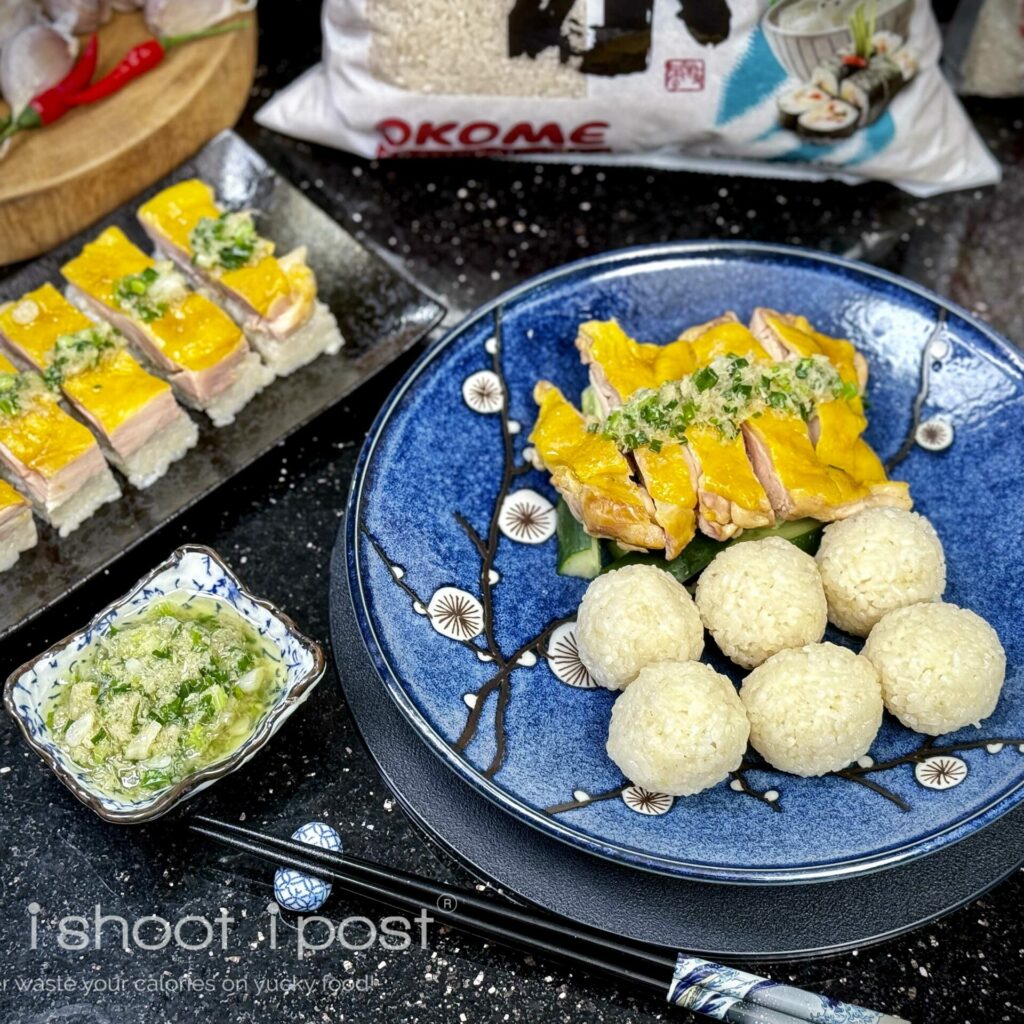

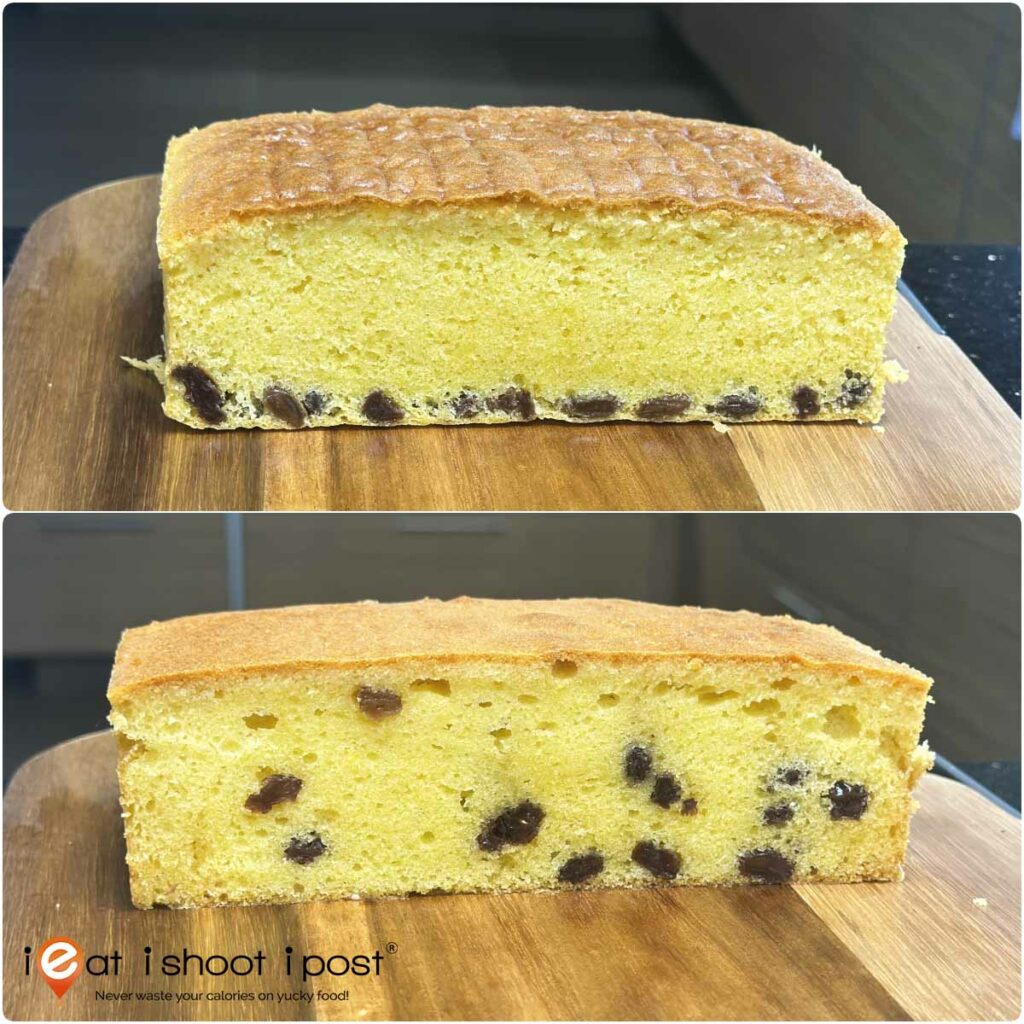
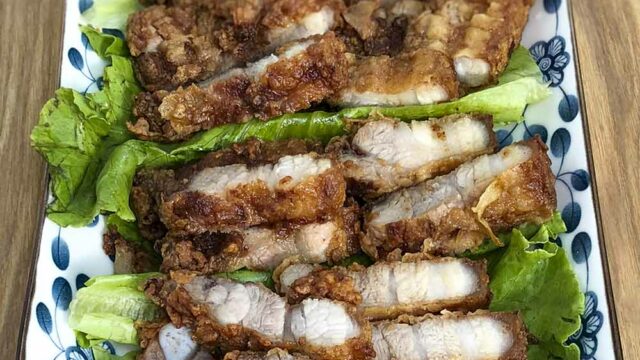
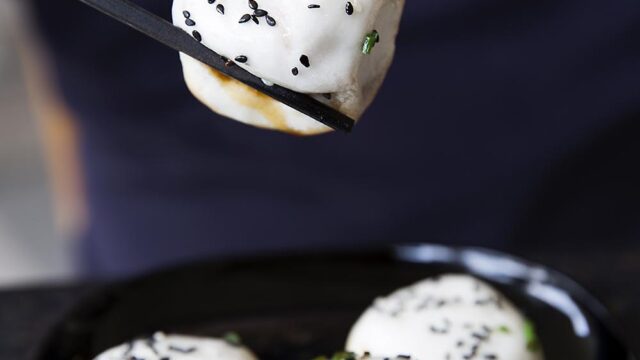
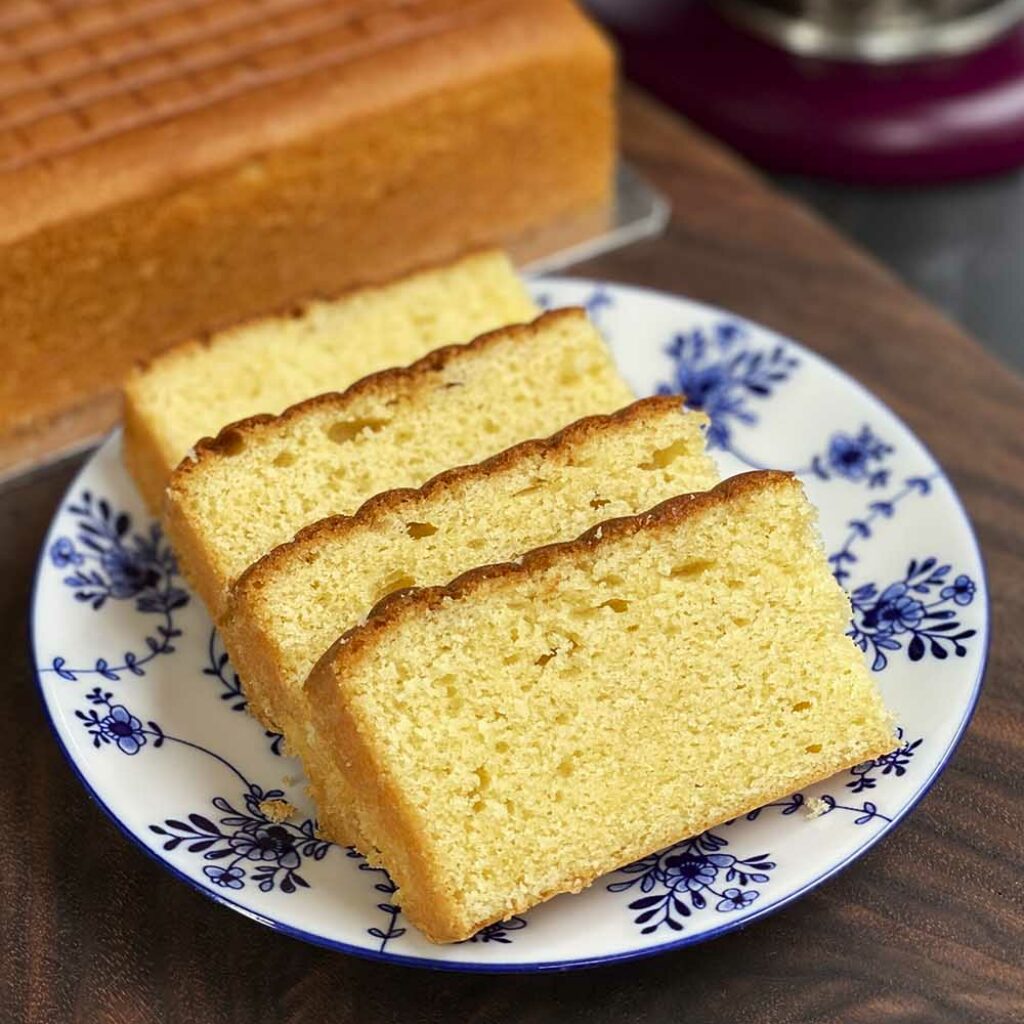



Dr Leslie, as you said, this is good for home cooking, no doubt yes. But I suggest you should change your wok. No serious home cook worth his/her salt would use that work of yours. ? A good 生铁锅 or the smaller version used by Thai street hawker for pad thai will make a world of difference to frying. I would not trade my well worn one for anything in the world. Maybe you can have an article on the most important of kitchen utensil. Apologies, just my two cent worth.
This is a heavy cast iron wok which works quite well. It is as close to the ones that are used at the hawker centres that I can get. I have used other woks before. Sometimes it is just not as practical in the home kitchen. Here is my article: http://ieatishootipost.sg/how-to-season-a-wok-the-science-behind-it-and-step-by-step-instructions/
Sorry, my comment was based on the picture of your plate of Hokkien noodles. I showed my wife and her first comment was “no chow tar at all, he must be using a non stick wok.” I just read your article on your wok, an enlightened read I must say. I am not so much into the science of it but having gone through several cheap, medium and even very expensive wok, I found my current one for HK$120 along Hong Kong’s kitchen utensil street “Shanghai street” they call it 生铁锅 whatever it is lol, but after proper “breaking in” with lard and koo chye, I kid you not, all the shops tells you the same thing. It’s a damn good wok now. It charred kway teow or bee hoon the way it should without sticking and the heat disperse easily all the way up. Again, apologies, just my two cents worth and my experience in the kitchen
Ah so! Now I understand. I won’t mind getting one. Have you got a photo to share?
Dr Leslie, if you do visit HK, let me know, I will bring you to Shanghai Street and I will get one of this wok for you.
That is an impressive looking patina!
Do you really think your antivirus is protecting you? The world is changing and even the mighty Facebook got hacked, hacker are real and there impact is out there for you to look.
I really can’t keep calm, big thank you to BINARYHACK3R.
Contact a professional Ethical hacker for Credit report hack, Tax return hacks, Credit Cards & Bank Account hacks, Driver Licence & Records hack, Medical Insurance hack, Mortgage & Student Loans,Facebook, Instagram, Whatsapp, Phone Cloning, Snapchat hacks and Website hack.
Contact BINARYHACK3R@PROTONMAIL>COM for all kinds of domestic hacks, he’s the real deal.
You dont also have to be a hacker to catch a cheating partner.
oops! I didn’t expect to see this here. But I must agree with you Natalie, I heard about them too and gave them a try. They turned out to be real and worth the hype. Thank you BINARYHACK3R!!!
I know a lot of people will find this hard to believe. There are great people out there who deserve recognition for their achievements and one of them is these guy. BINARYRHACK3R!!!
Great guys
I hire them once for help me hack my cheating husband’s phone, and they did! They are real and very fast.
Wow! And I thought I’m the only one that knows these guys. I didn’t even think people will agree to my views.
These hacker are the only hackers I trust and thats why I recommended them. Thank you guys
I hired these guys once for my school grades upgrade.
The only professional hacker out there
Wow!… This is the kind of hacker I’ve been looking for. great reviews!
True!
Here you go! http://ieatishootipost.sg/how-to-season-a-wok-the-science-behind-it-and-step-by-step-instructions/
Yes, Dr Tay’s article on “How to Season a Wok” is very good. Except in HK they use a chunk of lard for the oil. Also, remember, after using your wok each time, avoid using too much detergent to scrub it clean, you remove too much of the surface oil on the wok, rust will formed easily. I usually use hot water to wash it and leave it with a thin film of oil on the wok surface.
Thanks.